

|
Home Updates Hydros Cars Engines Contacts Links Racing Contact On The Wire |
|
Mats Böhlin. We have long admired enthusiasts who, for whatever reasons, set to and build their own engines for competition. If they are then successful that must bring immense satisfaction, and in our view sets them above those achieving the same with commercial equipment. Whilst not uncommon in the smaller classes of hydroplanes and cars, the 10cc classes have almost entirely remained the province of mass manufacturers. There has been one notable exception to this, the late Mats Böhlin, and it was learning that his cars were being sold that prompted the research and recording of his remarkable career in 10cc tethered car racing. |
|
|
|
Many of the successful tethered car competitors in Sweden had earlier, and equally impressive, careers in aeromodelling disciplines, which included free flight, speed flying and in particular, FAI team racing. Nils Björk and Rolf Hagel already having International Championships to their names before becoming involved with tethered cars. Mats Böhlin was also well established in both F2A speed flying and team racing from the early 1970s right through to the mid 90s. In F2C he initially used heavily modified K&B motors and later the BBF motors, a collaboration between him, his long time pitman Gösta Bengtsar and Brian Fairey, where each made different parts of the motor before assembling their own version. A great deal of experimentation was done on the K&B motors, especially alternatives to the drum valve including Mats' own centrifugal 'bell valve' before reverting to the axial flow type to avoid starving the big end of lubrication. Oddly, tethered cars still use the centrifugal type, probably because the mixture is so much richer? Left: Mats (facing camera) in T/R action at Woodvale World Championships in 1978 |
In the mid 70s Mats also converted a number of 2.5cc and 3.5cc front induction K&B glow motors to diesel. In the late 1980s he produced the first of his own engines to carry the MB name, the MB 2.5. Mats was a prolific engine builder throughout his career, but particularly during his team racing years. Converted K&B engines attributed to him have been seen with engine number 42, whilst the 1980s motor has a number of 205. During his time flying FAI classes, Mats featured in the Swedish Hall of Fame on many occasions, the last being in 1994.
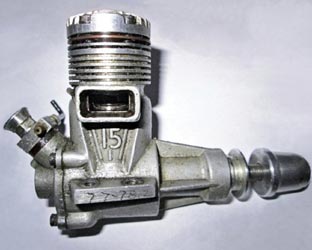 |
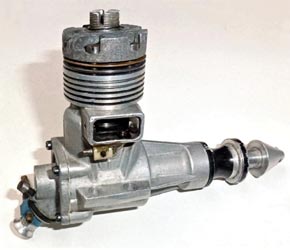 |
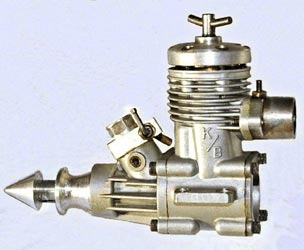 |
| Böhlin Modified K&B T/R special | Böhlin team Race Special #42 | Böhlin modified K&B 3.5 |
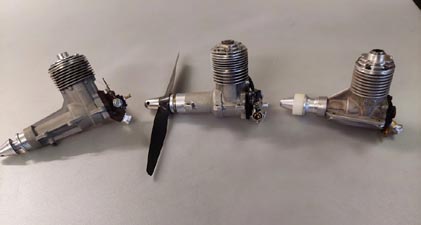 |
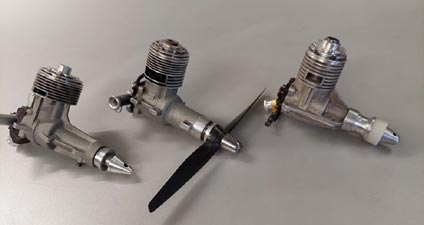 |
| Three of Mats' F2C TR motors | MB 2.5 1988 MB 2.5 1982 BBF 1978 |
|
The decision around 1998 to build his own 10cc motor to run in FEMA events appears to coincide with his involvement with tethered cars although the first record of him in the published results is in 2000 where he was using one of Ake Ekstrand's Class 2 (625) cars with a Picco motor. He was certainly active before this though, but without any results available to us prior to 2000, it is not possible to be precise as to when he began. For the 2001 season he used a Usanov car whilst he was building his own Class 2 cars that used Stelling motors. This was the first of three occasions where Mats would build two identical cars in parallel (895 and 896). Even after he moved into the 10cc Class (previously Class 4, later renamed Class V) Mats would continue to run his own 2.5cc car to the end of the decade, but only 895 seems to have made it on to the track. Right: Mats running his 2.5cc car |
|
|
|
Nearly six years of work and development went into the project before the MB10 motor appeared, with contemporary reports describing how the drum valve he used initially, was discarded and replaced by a conventional Zimmerman disc. The photograph to the left clearly shows the original 'bell' centrifugal drum valve to the rear of the engine. Also seen is the unusual exhaust manifold that predates the use of an exhaust valve. This was not his first foray into Class V however, as he had occasional runs with one of Lennart Hellander's Picco powered cars (094) in 2003. In 2004 Mats had the first run with an MB10 in a well travelled Bulgarian car built by Hristo Kerchev in the mid 80s (346). This had in turn been owned by Harald Arlautzki who had managed 329kph with it in competition and Leif Persson who did not run it at all before Mats got to work on it. Not too much of the original was left as Mats was incorporating his own ideas, and more importantly, his own engine. |
Although not the first to use what is often termed a 'power valve', all of Mats' motors were fitted with a shuttle exhaust valve that the Swedish refer to as an 'OMHD', Old Man's Horsing Device. Two stroke motor cycles used guillotine or rotary valves to improve low down power from around 1977, whereas racing hydroplanes had tuned pipes that could be extended by a foot pedal to achieve the same effect. The exhaust valve that Mats used had a flat plate, very lightly spring loaded, that opened with increasing centrifugal force, his own development of the principle. The tuned pipe he used was a large volume pipe by Edvard Stelling and extremely short. The new body was primarily of balsa, built by team race colleague Bengt Samuelson, and again to a somewhat different design to other cars of the period.
|
|
|
MB 10 in its final form, engine number 40, probably from the last batch of motors. Provision for the 'flood off' through the top of the massive 14mm venturi. Damper mounting is part of the exhaust valve |
With this set-up, the car recorded 339kph in practice, already 10kph faster than previously. As reported in the Swedish magazine, 'cars with pipes that short can't run like that, but the car does not know it'. A fifth place in its first race soon became a string of wins in Sweden at over 330kph. He did not run at the European Championship but travelled to Tallin for the World Championship where he finished second to Picco. A 331kph from earlier in the season secured him 4th place in the top 20.
|
|
|
Mats with 346 at Orebro in 2005 Nils Björk was also using MB10 motors in both of his cars during the 2005 season |
2005 was a year when all his efforts came to fruition with a string of first places, culminating in his first European Championship at Lyon in July, where his 331kph was 8km faster than second place Gualtiero Picco. It was also where we first came into contact with him, and an event that was largely responsible for OTW coming into existence. Less than a month later he travelled to New York for the AMRCA International where he finished third behind Paul-Otto Stroebel and Picco. More first places throughout the season gave him the Grand Slam and first place in the top 20 ahead of Johan Clason and Nils Björk. Closer to home, Mats was to make what would be the very last ever run at the Göteborg Large-Ring track, which closed that year. What became obvious from his cars and clearly illustrated in the photo above was that he was exploring a very different concept to most others with spats on the side of the pan to control the airflow under the car.
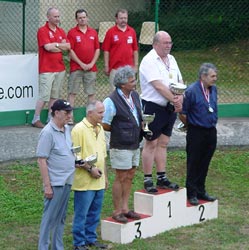 |
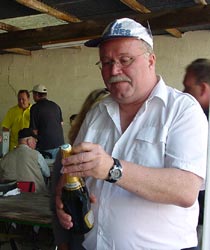 |
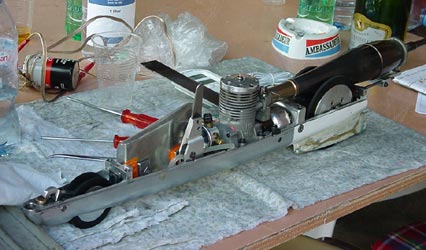 |
| Podium, Lyon 2005 | European Champion | No damping, spats and conventional 'knock off' |
| The podium at Lyon. R to L Gualtiero Picco, Mats Böhlin, Michel Duran, Walter Roder, Hans Isenegger | ||
During 2005 he was also building two entirely new cars, one for himself (1223) and one for Nils Björk (1224). This introduces another speed flyer from Sweden with a string of successes to his name, Leif Karrman. Leif was designing and building tether car, from the early 1970s, specialising in Class 1 cars with 1.5cc motors, which for several seasons were the fastest in Europe, breaking numerous records along the way, although these were never translated into success at Championship meetings. Leif was in the forefront of the design of the 'plate car', machined from bar stock, rather than a cast pan. Later, Leif began to supply cast pans for builders in Sweden, so for the two new 10cc cars Mats used cast 5cc Kman B pans, as explained to us, 'put the biggest motor you can in the smallest car'.
The cars differed in gears and the ratios used, 24 using Denneler gears and 23 with a gearbox of Mats' own design, machined from the solid. This design incorporated an outrigger bearing on the crown wheel side, which, in turn, required spiders for the wheels to allow room for the extra bearing and still keep the track to the same width as with a conventional gearbox. Mats also fitted a minute oiler, which can be seen attached to the gearbox mount that supplied oil directly to the gears via the red tube. As yet, how this works is something of a mystery
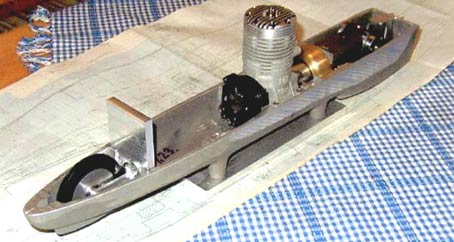 |
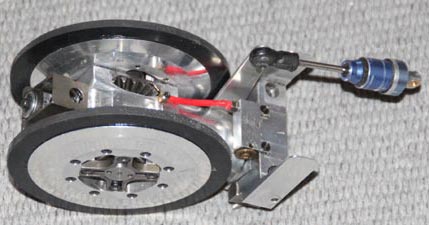 |
Above is 1223 at a very basic stage of the build, motor still fitted with drum valve induction. Also obvious is that a Denneler gearbox with a jury rigged outrigger bearing is being used as a mock-up to establish machining and clearances for the wider, home built box (right) that was to be fitted into this car. The spring damper has been replaced with a coil spring at the rear of the gearbox and separate damper unit. The spring is captive within the bridge, which makes the assembly self contained and so much easier to remove and put back in the pan.
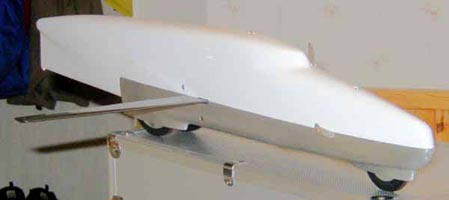 |
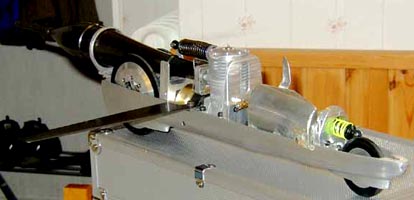 |
|
Pristine new car prior to its debut with a conventional fuel cutoff that would not meet current rules |
|
The fuel tanks were to his own design with the pick-up at the apex
of the outer angled sides and the breather pipe led outside the car and facing
the direction of travel. The angled sides to the tank gave a clear entry for the
air into the massive venturi, whilst the breather in the slipstream must have
pressurised the tank as well? Initially, a conventional fuel cut-off was fitted.
Later this was changed to a flood-off system. The composite bodies were again
built by Bengt Samuelsson with carbon reinforced nose and tail portions. These
two cars ran for the first time at Orebro in May 2006, one of the very few occasions that Nils beat Mats,
but both behind Johan Clason.
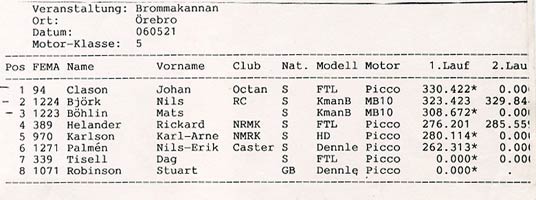
The inaugural run of 1223
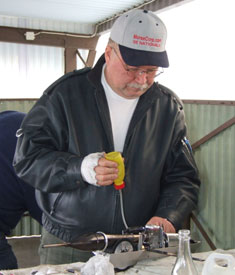 |
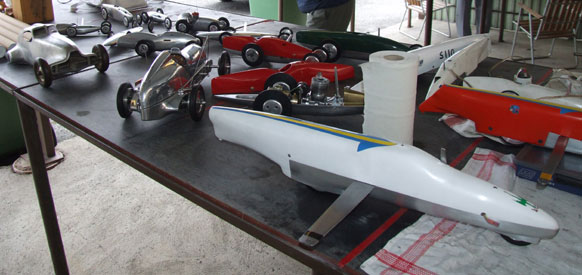 |
| Orebro 2006. Mats fuels 1223 | Orebro 2006, new cars. 1224 foreground, 1223 at rear, together with 2.5 (895) |
The first places soon came for 1223 with 336kph in Kapfenhardt and at Orebro in July, a new world record record of 338.425kph and a subsequent 1st in the top 20. His second run would also have broken the previous record. The readout from the run shows the car accelerating throughout the 8 laps with the last at 339.608kph. Next aim 340k. As well as building the new cars, his commitment to the project can be seen in photos that show batches of 12 MB10s in preparation, using crankcases cast by the Metkemeijer's in Holland, which Mats described as 'a hell of a lot of work'. In addition he was making exhaust valves for sale for 10cc engines and AFA 1.5cc motors, and if this was not enough, he also moved his entire workshop during the same period.
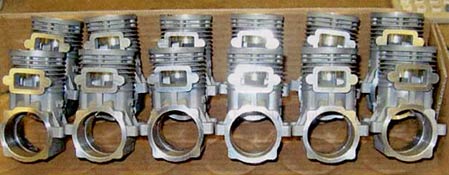 |
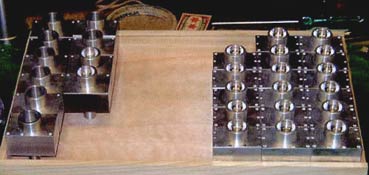 |
| Batch of 12 MB 10 crankcases after machining | 10cc and 1.5cc Exhaust valves |
All this heralded an unprecedented period of eight seasons for Mats as Nils Björk reverted to his own car in 2007, leaving Mats to run 1223 and 1224 as a pair at most races. For some inexplicable reason, 1223 was almost always the fastest, reaching 338kph again at several meetings to finish 2nd behind Picco in the top 20 by less than 1kph. For five years 1223 was the fastest 10cc car in Europe, producing another record in 2008 at Tallin with a run of 341.392kph.
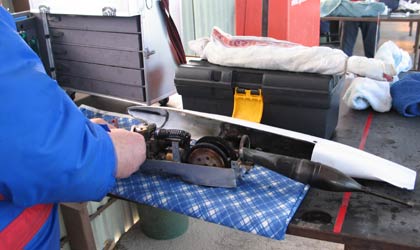 |
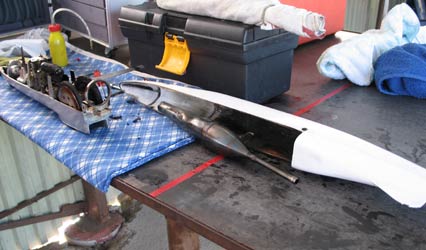 |
|
Orebro in 2008 and a fractured pipe does serious damage to 1224 |
|
In 2009 at the Orebro European Championships he proved total mastery in setting up his cars, with 1223 winning him his second European Championship and 1224 also recording 336kph, but just a few hundredths slower, which would also have also secured first place. If this was not in itself an incredible achievement, Mats repeated it at the 2010 Championship run at Kapfenhardt, with 1223 again running out the winner and 1224 second fastest but by a larger margin this time. It would take a lot of research and number crunching, but to achieve this two years running is surely unique? In Tallin in July, Mats achieved his best speed ever at 344.319km missing Picco's record by fractions of a kph. This was the fastest run of the season and notable that the top 3 were all over 340kph with results through the season giving him the Grand Slam again and it was to be another nine years before this speed was exceeded, ironically on a WMCR track.
From 2005, Mats maintained that controlling the airflow around the car was the key to speed, one of the reasons for using the 5cc pans, as these gave far greater ground clearance for the air to flow under the car, and by having the body cutaway at the back of the pan allowing it a clear exit. All three wheels had deep spats, whilst the body had a very low nose to create down force. Mats explained to us that it was the compression of the air between the fence and the car that slowed it down, so if you could get more underneath and over the top it would go faster, similarly if the distance between the car and the fence was larger then the car would go faster. His belief was that was why so many records had been set on WMCR tracks? Mats also incorporated a fuel flood off system that was proving popular at the time as it preserved the plug and kept the motor lubricated after it was shut off.
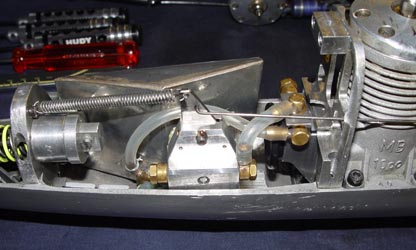 |
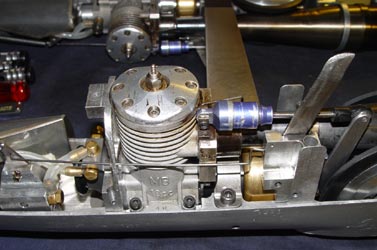 |
| Complex 'flood off' valve and unique tank shape | Remote lever and rod for 'knock off' |
Maintaining such a high level of performance is very difficult at the best of times, and even more so when all the equipment being used has to be produced in your own workshop as it multiplies the commitment to an almost unimaginable level. Given the serial numbers seen so far it seems that Mats must have built at least four batches of twelve MB 10s, another huge undertaking. In spite of this, he continued to compete at the highest level finishing with the fastest speed of the year for each of the next three years. He just missed out on a third consecutive European Championship in 2011 finishing second to Michel Duran. 2012 was his last European championship, finishing 4th but still with the fastest speed of the year to his name, a feat he repeated the following year, but by now 1223 and 1224 had eight seasons of hard racing behind them so Mats set to and built another matched pair of cars for the 2014 season. The new cars were noticeably different both in the design of the pan and the bodies, being even more compact. 1528 and 1529 would be run almost entirely in domestic events, sometimes alongside 1223, as he admitted to us that he had 'gone down a path that did not work and was having to rethink his approach'.
In 2016, he did venture to Kapfenhardt with both of the old cars, but in an uncharacteristically off weekend, neither would run properly with only one slow run throughout the competition. Sadly, this would be the last time that we met Mats, but it was a delight and valuable to have his insight into the design and setting up of a successful tethered car during a leisurely evening of food, drink and discussion.
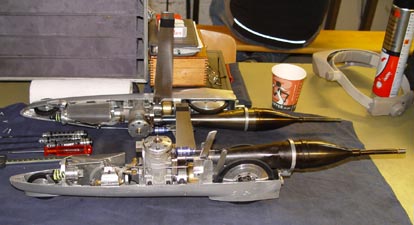 |
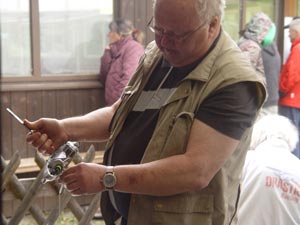 |
| 1223 foreground 1224 at rear | Mats blowing out the tank at Kapfenhardt |
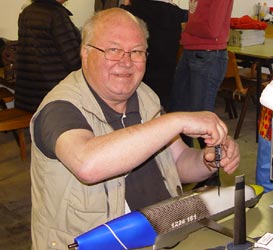 |
Despite continued efforts over the next two seasons the only high points would be winning the Swedish Championship in 2017 with 1223, probably its swansong and 2018 at 340kph with 1529, which was also the second fastest of the season, giving Mats his twelfth top three entry in the 'season's fastest'. The world was blissfully unaware of what was in store, but for Mats, 2019 was to be his last season, finishing at Orebro in September with a third place. In 2020 Everything changed with the arrival of Covid, although meetings did continue in Sweden, but without Mats. It was still a shock to us all, when we discovered at the end of the year that he had passed away, one of far too many, high profile, tethered car racers that would appear in our Empty Spaces tributes over the next two years. Left: Mats with 1224 at Kapfenhardt in 2016, sadly, a last photo. |
During 2021 we were told that all of Mats' modern cars were being sold, with some destined for Switzerland and one coming to the UK. From the FEMA registrations it was possible to establish that there were five 10cc cars and and three 2.5cc car still registered in his name, but which was going where would not be known until Kapfenhardt in 2022. We knew previously that the car that had come to the UK was one of the 2014 models and that the 2.5cc car was destined for Switzerland, although that turned out to be untrue, as we discovered in Germany. Jan Erik Falk arrived in Kapfenhardt with a boot full of cars and much unwrapping revealed the 2005 Championship car and one each of the 2005 and 2014 cars, along with the 2.5 car that had not in fact been sold. Jan-Erik also had a selection of beautifully machined parts for a second 2.5cc car. Was this the elusive 896? Arrangements to photograph and record the numbers of the 10cc cars on the Sunday fell through, so we were none the wiser as to the identities of the other 10cc cars. The 2.5cc car provoked a lot of interest but was apparently locked solid, although in discussion with Rain Teder I thought that it was just gummed up. Rain set to and took it apart, and yes, it was just old oil, so no more ado he relieved the wallets of his team members for enough Euros to take it back to Estonia. The parts of the second 2.5cc car were subsequently sold, but to whom is not currently known.
Update June 23: At Kapfenhardt, Rain confirmed that he had bought the parts to the second car and was in the process of completing it to make a matched pair as Mats did with his 10cc cars.
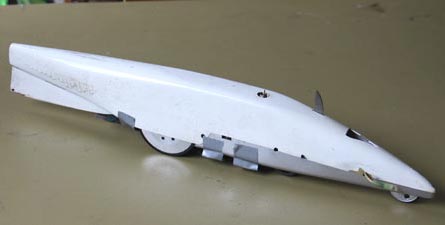 |
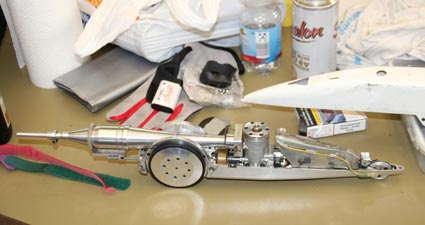 |
| Slightly worse for wear, the 2.5cc car | Intricate engineering throughout |
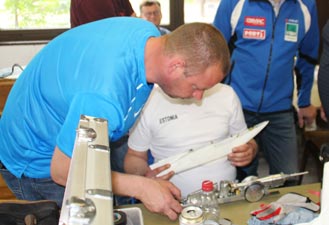 |
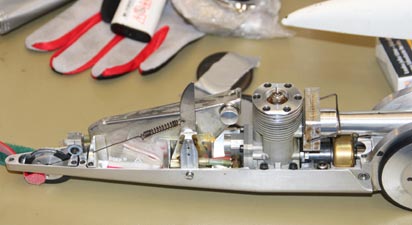 |
| Lauri Teder inspects Rain's purchase | Stelling motor and fuel system |
There was one 10cc car missing though, either 1224 or 1223, and that was back in Sweden as someone there had expressed an interest in it, but that eventually fell through, so a couple of weeks later a firm commitment to a sale was accepted. The car needed a thorough clean before it could be shipped and neither was it in good shape with a deranged rear suspension and other repairs needed, as it appears that it may have been in the process of upgrading or even as a donor for parts. Jan-Erik Falk also pointed out that the car needed a new fuel cut-off to replace the flood-off that had been removed, as that system prevents a restart if the car needs to be stopped for a mixture adjustment.
|
After several weeks stuck in a customs shed with increasingly nervous sender and recipient wondering whether it would ever be delivered, the ultimate Christmas parcel arrived. Just like Christmas too, as it was known what was in it, but which one of the two 2005 cars still to be discovered. Having been asked many years previously what the 'holy grail' would be, removing the last of the packing revealed it to be just that, 1223. Two European Championships, two records, six years the fastest in Europe, one Grand Slam and entirely the work of one man. Right: The ultimate Christmas present |
|
Since then, Michael Schmutz has registered 346, 1224 and 1529, whilst Rain has registered 895. 1528 is due to be registered in the name of the British owner, leaving the Ekstrand 2.5cc car 625 and 1223 the only cars still registered in Mats' name. This presented something of a dilemma, as running the car in anything other than an unofficial capacity would require it to be re-registered, and then the connection with Mats Böhlin would be lost entirely. There is also the small matter of there being no spares, should anything break. The damaged rear suspension is now repaired, and a bobbin style cut-off made previously by Mats now fitted. The flood-off was worked remotely by a lever way behind the motor whereas the new one had the lever in the more normal position, leaving a redundant slot in the body and all the original plumbing, now blocked off. Other than this the car will remain as Mats last used used it, including the enigma of the numbers 1523-171 that are part of the complex airbrushed paintwork on the bridle side of the body.
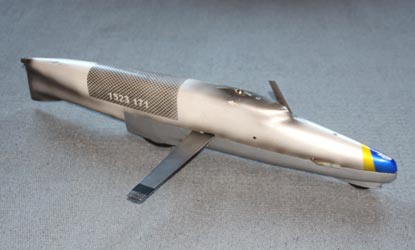 |
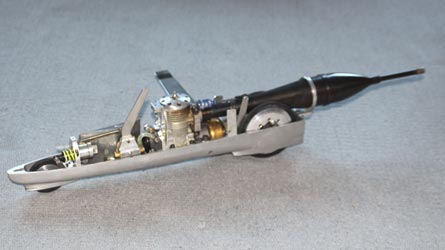 |
| Mats Böhlin's 1223 as it was last raced and will remain | Repairs completed and conventional 'knock off' now fitted |
All of the above was the result of a couple of chance conversations and a series of circumstances that just 'sort of happened', another true 'hadnabinfa? Thanks then are due to Oliver Monk for letting us know in 2021 that the cars were being sold, Jan-Erik Falk for arranging the sales, along with the shipping and deliveries, and John Goodall for providing the sources for much of the information including details and photos from Orebro and of Mats' Team Race motors. Thanks are also due to Adrian Duncan for permission to reproduce photos from his website where a very detailed article on Mats' work on K&B motors can be found. Much of the material has of necessity been translated from Swedish via a Google app that has made it all significantly easier, but may have introduced the odd error and involved changing a few words that could not possibly have been in the original text.
Cars run by Mats Böhlins as registered with FEMA, recorded
in race results and
with current location where known. If anyone is aware of any other cars or the
locations of the ones that cannot be accounted for, then we would be grateful to
allow the record to be completed.
Update: Oliver Monk has provided further information on 625. This was the
car used by Stan Barrett to set a new British record at Orebro in 2006, although
the car was never registered to him. Stan ran it under his name for three seasons before it
appears again being run by Ake Ekstrand in 2009, but still registered to Mats,
as it is currently. It was offered for sale a while ago.
| Number | Class | Chassis | Motor | Current location |
| 094 | Class 4 (5) | Helander | Picco | Not registered and location unknown |
| 246 | Class 2 | Usanov | Usanov | Sweden |
| 345 | Appears in results, but an error as this is a Class 1 car | |||
| 346 | Class 4 (5) | Bulgar | MB 10 | Switzerland |
| 625 | Class 2 | Xtra | Picco | Still registered to Mats Böhlin. See update above |
| 895 | Class 2 | MB | STL | Estonia |
| 896 | Class 2 | MB | STL | Estonia with 895 |
| 1223 | Class 4 (5) | KmanB | MB 10 #40 | UK but still registered To MB |
| 1224 | Class 4 (5) | KmanB | MB 10 | Switzerland |
| 1528 | Class 5 | Kman | MB 10 #47 | UK |
| 1529 | Class 5 | Kman | MB 10 | Switzerland |
©copyrightOTW2023